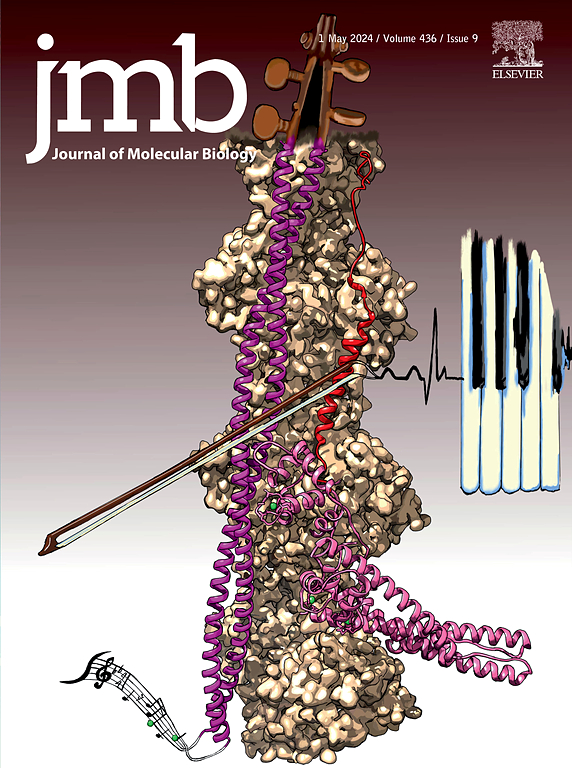OmpA Specifically Modulates the Activity of Enzymes that Reside in the Crowded Bacterial Outer Membrane
IF 4.7
2区 生物学
Q1 BIOCHEMISTRY & MOLECULAR BIOLOGY
引用次数: 0
Abstract
The outer membrane (OM) of lipopolysaccharide (LPS) containing-diderm bacteria is crowded with outer membrane proteins (OMPs) that reside in a membrane that is relatively rich in protein and poor in lipid. As a consequence, extensive interactions between OMPs occur. Yet, how these interactions affect OMP function remains unexplored. Here, we examine the effect of OmpA on the activity of three different OMP enzymes, OmpLA (a phospholipase), PagP (a palmitoyltransferase) and OmpT (a protease). We show that OmpA-OmpT interactions enhance the activity of OmpT, and that this catalytic enhancement is mediated via their extracellular loops, an effect that is not observed with other common OMPs, including OmpF and OmpX. In contrast, OmpA specifically reduces the activity of PagP, while OmpLA activity shows no significant change. Possible interactions between the abundant E. coli OMPs (OmpA, OmpF/C, OmpT, OmpX, MipA) and all other E. coli OMPs were screened via Alphafold predictions, with the results suggesting that smaller OMPs are generally more promiscuous interactors, and identifying new interactions that may plausibly form in the OMP-rich islands in the OM. Together, the results identify a previously underappreciated role for specific OMP–OMP interactions in modulating protein function in the OM, and highlight how evolution may have exploited the high local concentrations of abundant OMPs in the OM to tune enzyme activity.

OmpA专门调节居住在拥挤的细菌外膜酶的活性。
含脂多糖(LPS)细菌的外膜(OM)上挤满了外膜蛋白(OMPs),这些外膜蛋白(OMPs)居住在蛋白质相对丰富而脂质相对缺乏的膜上。因此,omp之间会发生广泛的相互作用。然而,这些相互作用如何影响OMP功能仍未被探索。在这里,我们研究了OmpA对三种不同的OMP酶,OmpLA(磷脂酶),PagP(棕榈酰转移酶)和OmpT(蛋白酶)活性的影响。我们发现OmpA-OmpT相互作用增强了OmpT的活性,并且这种催化增强是通过它们的细胞外环介导的,这一效应在其他常见的omp(包括OmpF和OmpX)中没有观察到。相比之下,OmpA特异性地降低了PagP的活性,而OmpLA的活性没有明显变化。丰富的大肠杆菌OMPs (OmpA, OmpF/C, OmpT, OmpX, MipA)与所有其他大肠杆菌OMPs之间可能的相互作用通过Alphafold预测进行筛选,结果表明较小的OMPs通常是更混杂的相互作用,并确定可能在OM中富含omp的岛屿中形成的新相互作用。总之,这些结果确定了一个以前被低估的作用,即特定的OMP-OMP相互作用在调节OM中蛋白质功能方面的作用,并强调了进化如何利用OM中丰富的高浓度局部omp来调节酶活性。
本文章由计算机程序翻译,如有差异,请以英文原文为准。
求助全文
约1分钟内获得全文
求助全文
来源期刊

Journal of Molecular Biology
生物-生化与分子生物学
CiteScore
11.30
自引率
1.80%
发文量
412
审稿时长
28 days
期刊介绍:
Journal of Molecular Biology (JMB) provides high quality, comprehensive and broad coverage in all areas of molecular biology. The journal publishes original scientific research papers that provide mechanistic and functional insights and report a significant advance to the field. The journal encourages the submission of multidisciplinary studies that use complementary experimental and computational approaches to address challenging biological questions.
Research areas include but are not limited to: Biomolecular interactions, signaling networks, systems biology; Cell cycle, cell growth, cell differentiation; Cell death, autophagy; Cell signaling and regulation; Chemical biology; Computational biology, in combination with experimental studies; DNA replication, repair, and recombination; Development, regenerative biology, mechanistic and functional studies of stem cells; Epigenetics, chromatin structure and function; Gene expression; Membrane processes, cell surface proteins and cell-cell interactions; Methodological advances, both experimental and theoretical, including databases; Microbiology, virology, and interactions with the host or environment; Microbiota mechanistic and functional studies; Nuclear organization; Post-translational modifications, proteomics; Processing and function of biologically important macromolecules and complexes; Molecular basis of disease; RNA processing, structure and functions of non-coding RNAs, transcription; Sorting, spatiotemporal organization, trafficking; Structural biology; Synthetic biology; Translation, protein folding, chaperones, protein degradation and quality control.
 求助内容:
求助内容: 应助结果提醒方式:
应助结果提醒方式:


